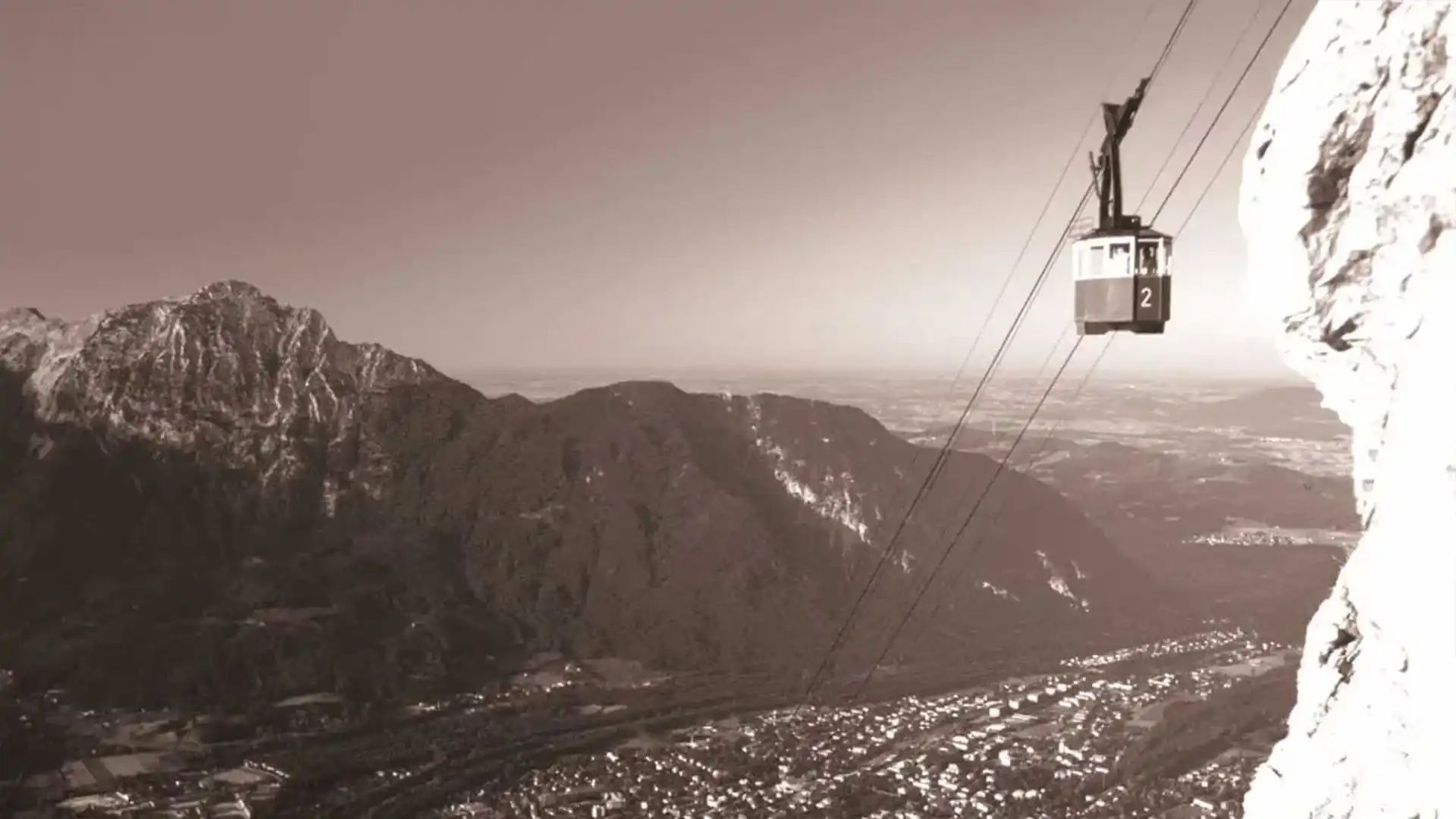

Monu
ment
protec
tion
Under monument protection worldwide
Completely deserved.
1.
1.
A model of perfection:
A completely unique aerial tramway
When the Predigtstuhlbahn commenced operations on July 1, 1928, the global response was unequivocal: Bad Reichenhall boasts the epitome of an aerial tramway. It surpasses all cable cars built up to that time in elegance, speed, and daring.
The prominently visible monumental pillars symbolize man’s mastery over nature and embody the zeitgeist of the 1920s. The downward-sloping pillars reinforce the upward momentum and bold aesthetics of the system in their distant effect. The straight alignment with gradients of up to 75% was a sensation at that time.


2.

2.
Functional technology
The entire drive and machinery system have operated purely mechanically and flawlessly since 1928. Nothing has changed to this day; everything remains in its original condition. Quality, robustness, and durability are the outstanding hallmarks of the technology on the Predigtstuhl. Nowhere else can cable car technology be admired in such pristine condition as on the Predigtstuhlbahn.

3.
3.
Floating pavilions
The Predigtstuhlbahn was also revolutionary in its cabins. The cars were constructed for the first time using new materials such as aluminum and Plexiglas in lightweight construction. The residents of Reichenhall desired “glass pavilions,” and the Bleichert company from Leipzig delivered. A completely new design was developed, which, as a dodecagon, was more streamlined than the previously typical bulky box cars. Additionally, a damper was installed, which still today cushions the rocking after passing the supports. The ride was therefore not just a means to an end but an experience in itself.



4.
Supporting cables that endure
The Predigtstuhlbahn also marks a turning point in cable technology. The problem with earlier cable cars was the frequent wire breakages in the supporting cables. The supporting cable of the Predigtstuhlbahn dates back to 1928 and is still as good as new. This is due to numerous innovations in wire rope technology on the one hand and new findings on cable tension on the other.
The heart of the valley station is therefore the tension room, located 14 meters below the surface. There, 104 tons of weight ensure that the supporting cables are as tightly stretched as possible and the cable line goes steeply upwards. A novelty for the time. The ingenious inventor of modern cable car technology, Alois Zuegg, had the then most powerful tension weights in the world installed in the Predigtstuhlbahn. What is standard today was revolutionary back then.

4.
5.
5.
Built to last forever
The buildings of the Predigtstuhlbahn belong to the architectural style of “New Objectivity” while being influenced by the so-called “Heimat style.”
The mountain and valley stations were built in 1927/28 and are visually reduced to their actual function. The dominant central building for the cabins with the platforms stands out, while waiting areas, administration, storage, and technical rooms are set back. The window openings decrease in size towards the top to echo the height of the mountain.
The mountain restaurant reinforces the character of the summit and represents an extension of the city. Therefore, the facade exhibits formal strictness. Wood as a building material was avoided. A conscious contrast to alpine huts was created for the fashionable and urban audience.


Bavarian monument conservation prize 2020
Am 17. September 2020 erhält die Predigtstuhlbahn den “Bayerischen Denkmalpflegepreis 2020” in Gold
On September 17, 2020, the Predigtstuhlbahn received the “Bavarian Monument Conservation Prize 2020” in Gold. Six Bavarian architectural monuments and their builders were awarded the Bavarian Monument Conservation Prize 2020 by Bavarian Minister of Construction Kerstin Schreyer and the President of the Bavarian Chamber of Engineers-Building, Prof. Dr. Norbert Gebbeken.
As reported by the Bavarian Chamber of Engineers-Building Munich in its press release, the Predigtstuhlbahn was awarded Gold in the “Private Buildings” category by the jury.
The jury justified their choice as follows:
The Predigtstuhlbahn, built in 1928 in Bad Reichenhall, is the oldest preserved large-cabin aerial tramway in the world. The steep route of 2,400 meters in length consists of three cable car supports with heights between 9 and 32 meters and a maximum cable span of almost 1,000 meters.
After massive damage became apparent at the three supports, the outstanding engineering structure was optimally restored under the most difficult conditions due to its geographical location and weather conditions. Since the restoration work had to be carried out during operation, material transport was carried out exclusively by helicopter. The largely preserved original concrete surfaces distinguish the restoration particularly. By foregoing standard solutions, a result was achieved that can not only be described as exemplary in terms of monument compatibility but even sets new standards.
We would like to express our heartfelt thanks for the excellent advice and performance of the executing engineering office Dr. Schütz Ingenieure from Kempten. Likewise, we extend our greatest thanks and respect to the executing company Schupp from Stödtlen, which, under the direction of owner Heiko Schupp, spent months tirelessly and with full commitment to realize the extensive support restoration under extremely adverse conditions. We are very proud!
